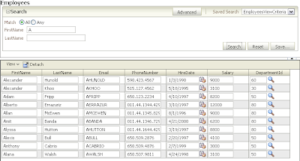REQUEST COMPLIMENTARY SQLS*PLUS LICENCE
SQL Indexes

SQL Indexes – The index is a method of performance tuning that allows for much faster retrieval of records. The index creates a record for each value that appears in the indexed columns. Each index name must be unique in the database.
Create an index
You can create indices in SQL using the CREATE INDEX operator.
CREATE INDEX syntax in SQL
CREATE [UNIQUE] INDEX index_name_id
ON table_name_id column1_id, column2_id, ... column_n_id);
- UNIQUE – The UNIQUE modifier indicates that the combination of values in the indexed columns should be unique
- index_name_id – The name to be given to the index
- table_name_id – Name of the table where the index should be created
- column1_id, column2_id,… column_n_id – Columns for index use
Example:
Let us consider an example of how to create an index in SQL.
For example:
CREATE INDEX webs_idx
ON webs (site_name_id);
In this example, we created an index for a website table called webs_idx. It consists of only one field, the site_name_id field.
We could also create indexes with more than one field, as shown below.
CREATE INDEX webs_idx
ON webs (site_name_id, server_id);
This will create the webs_idx index, which consists of two columns – site_name_id and server_id.
UNIQUE INDEX
Like the primary key, a unique key allows you to select one column or a combination of columns that should be unique for each record.
To create a unique index for a table, you must specify the UNIQUE keyword in the CREATE INDEX statement.
For example.
CREATE UNIQUE INDEX webs_idx
ON webs (site_name_id);
This will create a unique index in the field site_name_id, so that this field must always contain a unique value without duplicates. This is a great way to ensure the integrity of your database if you require unique values in columns that are not part of your primary key.
Delete index
You can delete indexes in SQL using the DROP INDEX operator.
Syntax for removing an index in SQL
For Oracle and PostgreSQL.
DROP INDEX index_name_id;
For MySQL and MariaDB.
DROP INDEX index_name_id; for MySQL and MariaDB.
ON table_name_id;
For SQL Server.
DROP INDEX table_name_id.index_name_id;
- index_name_id – Index name to delete
- table_name_id – Name of the table to which the index belongs
Example:
Let’s look at an example of how to remove an index with the name sites_idx from a site table.
For Oracle.
DROP INDEX webs_idx;
Since each index name must be unique in the database, we do not need to specify the websites table in the Oracle DROP INDEX operator.
For MySQL and MariaDB.
DROP INDEX webs_idx
ON webs;
For SQL Server.
DROP INDEX webs.webs_idx;
As you can see, each database has unique differences in its syntax. Make sure that you use the correct DROP INDEX command.
SQL Index. Indexes in SQ. Database Index
MORE NEWS
PreambleNoSql is not a replacement for SQL databases but is a valid alternative for many situations where standard SQL is not the best approach for...
PreambleMongoDB Conditional operators specify a condition to which the value of the document field shall correspond.Comparison Query Operators $eq...
5 Database management trends impacting database administrationIn the realm of database management systems, moreover half (52%) of your competitors feel...
The data type is defined as the type of data that any column or variable can store in MS SQL Server. What is the data type? When you create any table or...
PreambleMS SQL Server is a client-server architecture. MS SQL Server process starts with the client application sending a query.SQL Server accepts,...
First the basics: what is the master/slave?One database server (“master”) responds and can do anything. A lot of other database servers store copies of all...
PreambleAtom Hopper (based on Apache Abdera) for those who may not know is an open-source project sponsored by Rackspace. Today we will figure out how to...
PreambleMongoDB recently introduced its new aggregation structure. This structure provides a simpler solution for calculating aggregated values rather...
FlexibilityOne of the most advertised features of MongoDB is its flexibility. Flexibility, however, is a double-edged sword. More flexibility means more...
PreambleSQLShell is a cross-platform command-line tool for SQL, similar to psql for PostgreSQL or MySQL command-line tool for MySQL.Why use it?If you...
PreambleWriting an application on top of the framework on top of the driver on top of the database is a bit like a game on the phone: you say “insert...
PreambleOracle Coherence is a distributed cache that is functionally comparable with Memcached. In addition to the basic function of the API cache, it...
PreambleIBM pureXML, a proprietary XML database built on a relational mechanism (designed for puns) that offers both relational ( SQL / XML ) and...
What is PostgreSQL array? In PostgreSQL we can define a column as an array of valid data types. The data type can be built-in, custom or enumerated....
PreambleIf you are a Linux sysadmin or developer, there comes a time when you need to manage an Oracle database that can work in your environment.In this...
PreambleStarting with Microsoft SQL Server 2008, by default, the group of local administrators is no longer added to SQL Server administrators during the...















